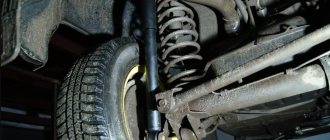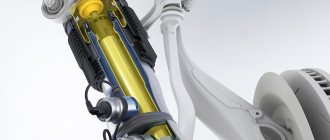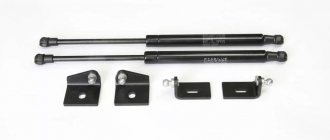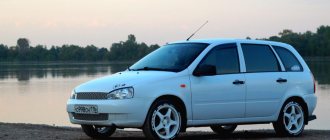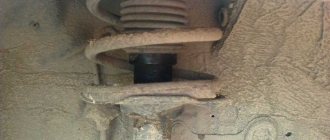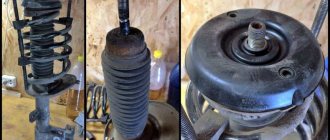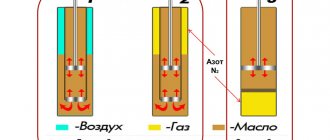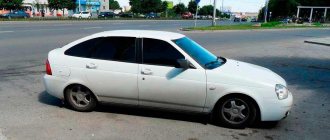For the first time, AvtoVAZ developed individual shock absorbers. They are installed only on Vesta. Drivers of Lada Vesta cars note the advantages of the brand. Among them are high ground clearance, sound insulation, and maneuverability. They also note a significant drawback of all Lada Vesta cars - knocking in the rear part of the suspension. The manufacturers said that a similar phenomenon occurred and explained that the extraneous sounds arise from the shock absorbers of the Vesta. To get rid of it, you just need to select washers of a certain size for the front supports for the struts, or you will need to overhaul the suspension and replace the part. When the time comes to replace it, you will need to look for original racks, or select them according to parameters from possible analogues. Read the article and your suspension will work smoothly and safely.
The shock absorbers installed on Vesta from the factory are the same regardless of the vehicle’s configuration. They are produced by a Russian plant. SAAZ struts are installed on the front and rear suspension of the Lada Vesta, which translates to: Skopinsky Automotive Aggregate Plant. There is a plant in the Ryazan region. They are gas, which differ from oil, or combined.
The two front parts are different. Therefore, the left and right spare parts are marked with an individual article number. Drivers note that the Lada's suspension is reliable; if the vehicle is used carefully, the shock absorbers will last a long time.
Which shock absorbers are better to install on Lada Vesta
The main task of shock absorbers is to keep the wheel in constant contact with the road to avoid loss of control over the car.
Currently, Vesta offers a large variety of shock absorbers from different manufacturers. Let's figure out which shock absorbers are better to choose: original or analogue. Article numbers of original Lada Vesta front suspension parts
:
- 8450006745 and 8450006744 — Telescopic stand left and right assembled (SAAZ)
- 8450031057 (8450033433) and 8450031056 (8450033432) — Telescopic stand left and right assembled Cross (LADA Izhevsk)
- 8450032654 and 8450032653- Telescopic stand left and right assembly Sport (Lada-Sport)
- 8450033433 (8450031057) and 8450033432 (8450031056) — Telescopic stand left and right assembled Cross (SAAZ)
Article numbers of original Lada Vesta rear suspension parts
:
- 8450006786 — Rear suspension shock absorber assembly (SAAZ)
- 8450031059 — Shock absorber rear suspension assembly Cross (LADA Izhevsk)
- 8450032657 — Shock absorber rear suspension assembly Sport (Lada-Sport)
Every shock absorber manufacturer claims that their products are superior to OEM parts. For example:
- more comfortable and smooth passage of small and large road irregularities;
- more reinforced shock absorber design;
- ability to select the level of hardness;
- lowering suspension kit;
- etc.
This allows Vest owners to choose shock absorbers that best suit their specific driving style.
Determined by voting
:
- Which brand of shock absorbers did you choose?
- What is more important to you: comfort or controllability?
- What was the service life of the factory shock absorbers?
Leave your feedback in the comments, take part in the survey!
Source
How to choose the right analogue
Replacing a shock absorber begins with its selection and purchase. To choose the right part, you should take into account the quality of the road surface. For rough roads, experienced drivers recommend installing soft shock absorbers. The plush suspension compensates for road unevenness and improves ride comfort. The downside is loss of stability at high speeds. If the road is good, you can install extremely tight racks. This will help increase the machine's operating speeds and minimize roll in turns, reducing sideways pulls.
Features of Vesta car shock absorbers
The front shock absorbers have the appearance of classic MacPherson struts and have the following characteristics:
| Catalog number | 8450006745 (left) |
| Shock absorber type | Gas |
| Bottom mount | Eyelet + rubber-metal joint |
| Top mount | Stock |
| Rod diameter | 20 mm |
| Case diameter | 48.5 mm |
A special feature of the rear shock absorbers is their separate location from the springs. These are double-sided gas shock absorbers, which differ from other VAZ models in their size.
| Catalog number | 2180-2915402 |
| Shock absorber type | Gas |
| Axle (installation side) | Rear, right, left |
| Bottom mount | Eyelet + rubber-metal hinge |
| Top mount | Stock |
| Rod thread parameters | M10x1.25 |
| Connection length 2 | 602±3 mm |
| Connection length 1 | 375±3 mm |
| Rod diameter | 12.5 mm |
| Casing diameter | 47 mm |
| Rod stroke | 237 mm |
Rear shock absorber
Unlike other Lada cars on Vesta, the springs and shock absorber struts in the rear suspension were blown apart. Thus, to replace the springs, the struts do not need to be dismantled. In addition, the rear shock absorbers are mounted differently at the top point; now there is no need to hold the nuts from the interior.
You will need: remove the wheel and raise the car to a height convenient for performing work, head “16”, “21”.
Place a transmission rack type SG-1 (No. 2) under the lever (Fig. 11-1, No. 1) and lower the car until the spring begins to compress. Release the shock absorber from the rear suspension arm by removing the bolt (No. 3).
Unscrew the two upper bolts (Fig. 11-2, No. 1) securing the strut to the body. Remove the rear shock absorber assembly with compression stroke buffer and upper support.
Installation is performed in reverse order.
Let us remind you that you can study the design of the Lada Vesta suspension in more detail, as well as find out reviews about it, in this article.
Share on social networks:
Found an error? Select it and press Ctrl+Enter..
Source
How do you know if a shock absorber has failed?
The first sign of a damaged rack will be discomfort when hitting an obstacle.
The lack of proper shock absorption is very noticeable in the cabin. The following signs will help you suspect a malfunction:
- Unusual sounds from the suspension. They may be constant or occur only during off-road driving;
- The car's controllability has decreased, the car skids and sways from side to side.
- The ground clearance has decreased (the car has sank).
- If the shock absorbers are oil or gas oil, they may leak. The appearance of drips on the racks indicates that they need to be replaced. The leakage of gas struts can be determined by the characteristic hissing sound made by the gas escaping from them.
If you have such problems, you need to contact a service station, where they will carry out diagnostics and find out the causes of the problem. If you have a suitable location and the necessary equipment, you can inspect and identify the problem yourself.
How to increase the service life of racks
Experienced drivers have developed their own procedure for extending the life of car suspension parts.
- Completely eliminate high-speed driving on bumpy roads. The main factor that causes shock absorbers to fail is the presence of shocks to the suspension. This is especially painful at high speeds.
- Maintains correct tire pressure. Car tires also participate in shock absorption, as do damper inserts. It is optimal to monitor the indicators inside the wheels every 500 - 700 kilometers. The bottom line is that the built-in puncture sensors may not work or display data incorrectly.
- Timely prevention and diagnostic procedures. Actions will help prevent serious problems with the chassis of the car. When play forms inside hinges or joints, uncontrolled destruction of parts occurs.
- No overload. The machine is not designed to transport heavy loads. If you consistently overload the suspension, you can quickly kill it.
- Installation of high-quality consumables. Some users are trying to save money by purchasing original parts or high-quality analogues, preferring cheap components. It should be understood that a penny saving on parts can result in an expensive, comprehensive suspension repair.
Cost of shock absorbers for Lada Vesta
Many drivers are interested in the question, what shock absorbers are installed on Vesta from the factory? According to information from official sources, Lada Vesta cars of all modifications are equipped with Russian-made parts. They are manufactured by the Russian company SAAZ (Skopinsky Automotive Aggregate Plant), specially commissioned by AvtoVAZ. These racks are adapted for difficult road conditions and have proven themselves in practice.
If replacement is necessary, the driver can purchase original spare parts that are commercially available. You can also use analogues, which are also widely available on the shelves of auto stores. The cost of shock absorbers from different manufacturers is presented in the following table:
Cost (front/rear)
| Manufacturer | vendor code | ||
| Demfi (Russia, Skopino) | SFC8012 | SRC8012 | |
| SS20 (Russia) | OEM 8450006744 and 8450006745 | OEM 8450006786 | 6490 RUR/2 pcs. |
| Finwhale (Germany) | 13081GR | ||
| Trialli (Russia, Türkiye) | AG1365 | ||
| Pilenga (Italy) | SH-P2712G | 2300 rub/piece | |
| Stellox Germany (produced in Macedonia, Turkey, Poland) | 4214-0108-SX *Prices are valid as of August 2022 | ||
Front shock absorber strut
You will need: remove the wheel, jack up the car, a 13mm, 16mm, 18mm wrench, and a flat screwdriver.
We disconnect the stabilizer strut from the shock absorber by unscrewing the nut (Fig. 3-1, No. 2), holding the pin (No. 3) from turning.
Remove the speed sensor wires (Figure 3-2, No. 2) from the bracket on the body (No. 1). Disconnect the steering knuckle from the suspension strut by unscrewing the two nuts (No. 4) and removing the bolts (No. 6).
Remove the frill (wind flap) using a flat-head screwdriver. Unscrew the three bolts (Fig. 3-3, No. 2) securing it to the body. Together with an assistant, remove the front shock absorber strut assembly with the spring and upper support.
Installation is carried out in reverse order. After lowering the car to the ground, finally tighten the bolts securing the suspension strut to the body.
The advantage of Vesta's front suspension design over other Lada models is that after replacing the shock absorber struts, there is no need to adjust the wheel alignment.
Reviews and recommendations from Lada Vesta owners
Positive
NegativeWith a mileage of 38 thousand, strange sounds began to arise from the front suspension. It turned out that the racks were rattling and had already exhausted their service life. I decided to replace the original shock absorbers with the manufacturer Acomi. After I ordered on the official website, the manager immediately called back and clarified the details. The parcel arrived in Tula in 4 days, the details are as in the picture, packed in boxes. I’ve been driving on the new shock absorbers for a month now, and so far I can’t say anything bad - they cope with unevenness and obstacles perfectly. After replacing the original front struts with Acomi ones, the car began to handle worse. With the Saazov struts, it seemed to be more confused; I always knew how the car would behave in a given situation. Now, when cornering, the car sways a little and in a strong crosswind, strange vibrations are felt. The original shock absorbers were still better.On the plus side, I note that the new struts are a little quieter and give a smoother ride.
Source
Front suspension device
Myths are already beginning to form about the handling of the LADA Vesta SW Cross, the suspension of which has not only design, but also standard features. Before a detailed examination of the front suspension design, we will highlight radically new solutions that allowed Vesta to stand on a par with the brainchild of Korean and even German concerns.
There are no objective reasons to abandon the MacPherson-type independent suspension, but several steps forward have turned the new product into a competitive car that can withstand the onslaught of not only Russian roads, but also numerous test drive enthusiasts.
- For the first time, a subframe appeared on a Russian car . Some components migrated from the body to the auxiliary platform. The time has come to talk about increasing the level of comfort associated with vibration damping.
- The new shape of the anti-roll bar contributes to a more responsive distribution of forces along the axle.
- The stabilizer is attached by means of struts with hinged ends . Compared to the struts that were installed on all models of the ninth and tenth families, this design saved the car from excessive roll, especially when cornering.
- The L-type lower wishbone is attached to the subframe at two points. Let us recall that previously a lever fixed at one point avoided longitudinal displacement by stretching. As a result, excessive play was formed. When braking, characteristic “pecks” of the nose were observed.
The diagram depicting the front suspension structure clearly shows all the main components.
- Spar , or rather, the part of it to which the subframe is attached. Many owners note a rigid connection as a disadvantage. Silent blocks have been used on many foreign cars for a long time.
- Subframe . It is hollow but durable. The cavity makes the assembly minimal in weight, although the thickness of the metal is impressive. The subframe experiences enormous loads while driving.
- L-shaped front suspension arm. In the diagram you can distinguish the places where the lever is attached using silent blocks.
- Rounded fist . It does not play a fundamental role in improving the basic parameters of the suspension, but the designers note that Vesta was equipped with new steering knuckles.
- Telescopic stand with support and support bearing. It cannot but affect the performance, but it is still a design feature rather than a standard innovation.
- Stabilizer and anti-roll bars.
This is interesting: Online store of auto parts for VAZ
Front shock absorber strut
You will need: remove the wheel, jack up the car, a 13mm, 16mm, 18mm wrench, and a flat screwdriver.
We disconnect the stabilizer strut from the shock absorber by unscrewing the nut (Fig. 3-1, No. 2), holding the pin (No. 3) from turning.
Remove the speed sensor wires (Figure 3-2, No. 2) from the bracket on the body (No. 1). Disconnect the steering knuckle from the suspension strut by unscrewing the two nuts (No. 4) and removing the bolts (No. 6).
Remove the frill (wind flap) using a flat-head screwdriver. Unscrew the three bolts (Fig. 3-3, No. 2) securing it to the body. Together with an assistant, remove the front shock absorber strut assembly with the spring and upper support.
Installation is carried out in reverse order. After lowering the car to the ground, finally tighten the bolts securing the suspension strut to the body.
The advantage of Vesta's front suspension design over other Lada models is that after replacing the shock absorber struts, there is no need to adjust the wheel alignment.
Rear shock absorber
Unlike other Lada cars on Vesta, the springs and shock absorber struts in the rear suspension were blown apart. Thus, to replace the springs, the struts do not need to be dismantled. In addition, the rear shock absorbers are mounted differently at the top point; now there is no need to hold the nuts from the interior.
You will need: remove the wheel and raise the car to a height convenient for performing work, head “16”, “21”.
Place a transmission rack type SG-1 (No. 2) under the lever (Fig. 11-1, No. 1) and lower the car until the spring begins to compress. Release the shock absorber from the rear suspension arm by removing the bolt (No. 3).
Unscrew the two upper bolts (Fig. 11-2, No. 1) securing the strut to the body. Remove the rear shock absorber assembly with compression stroke buffer and upper support.
Installation is performed in reverse order.
Let us remind you that you can study the design of the Lada Vesta suspension in more detail, as well as find out reviews about it, in this article.
Share on social networks:
Found an error? Select it and press Ctrl+Enter..
Source
